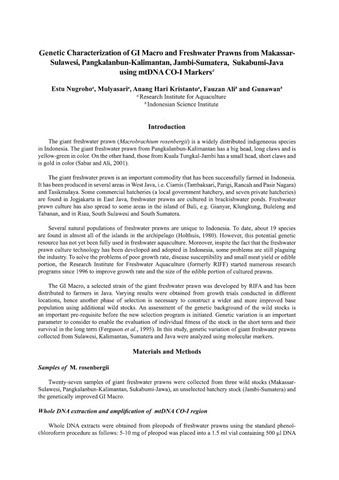Perlihatkan publikasi sederhana
Genetic diversity in farmed Asian Nile and red hybrid tilapia stocks evaluated from microsatellite and mitochondrial DNA analysis
| dc.contributor.author | Romana-Eguia, Maria Rowena R. | |
| dc.contributor.author | Ikeda, Minoru | |
| dc.contributor.author | Basiao, Zubaida U. | |
| dc.contributor.author | Taniguchi, Nobuhiko | |
| dc.date.accessioned | 2014-05-12T05:29:33Z | |
| dc.date.available | 2014-05-12T05:29:33Z | |
| dc.date.issued | 2004 | |
| dc.identifier.citation | Romana-Eguia, M. R. R., Ikeda, M., Basiao, Z. U., & Taniguchi, N. (2004). Genetic diversity in farmed Asian Nile and red hybrid tilapia stocks evaluated from microsatellite and mitochondrial DNA analysis. Aquaculture, 236(1-4), 131-150. | en |
| dc.identifier.issn | 0044-8486 | |
| dc.identifier.uri | http://hdl.handle.net/10862/2025 | |
| dc.description.abstract | We analyzed microsatellite and mitochondrial DNA restriction fragment length polymorphism (mtDNA-RFLP) in two domesticated (NIFI and Israel) and four genetically improved (GIFT, GMT, FAC-selected and SEAFDEC-selected) Nile tilapia (Oreochromis niloticus) as well as five red hybrid tilapia (Oreochromis mossambicus × O. niloticus) stocks (BFS, FACred, NIFIred, HL, and PF) farmed in Asia. Microsatellite variation at five loci (UNH216, UNH172, UNH123, UNH147, UNH222) was more informative in characterizing stock differences than the mtDNA-RFLP markers that were based only on 14 restriction morphs. Contemporary microsatellite data showed that GIFT Nile tilapia had the highest mean expected heterozygosity (H>e=0.813), while GMT had the lowest (He=0.666). The unselected NIFI stock and SEAFDEC-selected were genetically similar, while GMT differed significantly from the other Nile tilapia stocks. Among the red tilapias, NIFIred had the highest He (0.715), while BFS had the lowest variability (He=0.567). The Taiwanese red tilapia HL and Thai NIFIred were genetically similar. Except for NIFI, most of the Nile and red tilapia stocks exhibited remarkably significant homozygote excess relative to Hardy–Weinberg Equilibrium (HWE), suggesting some degree of inbreeding. Asian Nile tilapias were more genetically diverse (pooled He=0.791; mtDNA nucleotide divergence value dA=0.009) than the red tilapias (pooled He=0.697; mean dA=0.004). This slight divergence between the Nile and red tilapias was also seen in the analysis of molecular variance (AMOVA; FCT=0.0018) and in genetic distance and nucleotide divergence dendrograms. However, the AMOVA revealed that the greater percentage of variation (99.33%) in the total genetic diversity of the surveyed stocks is principally due to differences at the individual level and not between nor within groups. The significance of these results is that they reflect and lead to new inferences regarding the selective breeding and culture methods used in managing these farmed stocks. | en |
| dc.description.sponsorship | The authors would like to thank Drs. Tereso A. Abella, Remedios Bolivar and Jose Abucay of FAC-CLSU, Mr. Basilio Rodriguez Jr. and his staff at GIFT Foundation International and PhilFishGen for allowing the collection of fin-clip samples from their tilapia breeding stocks. The assistance of Ruel V. Eguia, Adelaida L. Arago, Bienvenido Banaag and Federico Reyes of SEAFDEC/AQD is likewise appreciated. M.R.R. Eguia is grateful to the Philippine Department of Science and Technology for their support and to the Japan Society for the Promotion of Science for providing research funds for this study. | en |
| dc.language.iso | en | en |
| dc.publisher | Elsevier | en |
| dc.subject | Oreochromis niloticus | en |
| dc.subject | Asia | en |
| dc.subject | Israel | en |
| dc.subject | Genetically improved stocks | en |
| dc.subject | Mitochondrial DNA-RFLP | en |
| dc.subject | tilapia | en |
| dc.title | Genetic diversity in farmed Asian Nile and red hybrid tilapia stocks evaluated from microsatellite and mitochondrial DNA analysis | en |
| dc.type | Article | en |
| dc.identifier.doi | 10.1016/j.aquaculture.2004.01.026 | |
| dc.citation.volume | 236 | |
| dc.citation.issue | 1-4 | |
| dc.citation.spage | 131 | |
| dc.citation.epage | 150 | |
| dc.citation.journalTitle | Aquaculture | en |
| seafdecaqd.library.callnumber | VF SJ 0772 | |
| seafdecaqd.databank.controlnumber | 2004-09 | |
| dc.subject.asfa | DNA | en |
| dc.subject.asfa | fish culture | en |
| dc.subject.asfa | genetic variation | en |
| dc.subject.asfa | hybrid culture | en |
| dc.subject.asfa | microsatellites | en |
| dc.subject.asfa | inbreeding | en |
| dc.subject.asfa | nucleotides | en |
| dc.subject.asfa | selective breeding | en |
Files in this item
| Files | Size | Format | View |
|---|---|---|---|
|
There are no files associated with this item. |
|||
Publikasi ini ada di koleksi berikut
-
Journal Articles [1256]
These papers were contributed by Department staff to various national and international journals.




